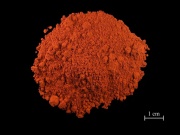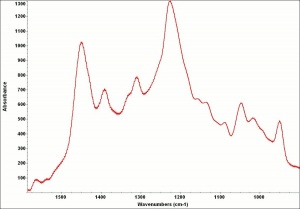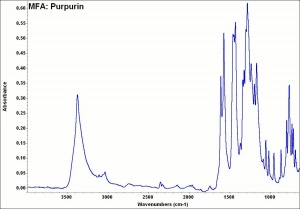Difference between revisions of "Purpurin"
m (Text replace - "== Authority ==" to "== Sources Checked for Data in Record ==") |
m (Text replace - "\[http:\/\/cameo\.mfa\.org\/materials\/fullrecord\.asp\?name=([^\s]+)\s(.*)\]" to "$2") |
||
| Line 2: | Line 2: | ||
== Description == | == Description == | ||
| − | One of the natural colorants extracted from [ | + | One of the natural colorants extracted from [[madder|madder]] roots and other Rubiaceae family plants. Purpurin has been manufactured synthetically by the oxidation of alizarin since the 1920s. Purpurin forms a brilliant red color when mordanted with aluminum salts. It is not considered a permanent artists pigment (Mayer 1969). In red dyed fabric, the presence of purpurin along with [[alizarin%2C%20natural|alizarin]] has been used to distinguish natural madder dyes from the [[alizarin%2C%20synthetic|synthetic alizarin]] dyes first sold in 1871. Purpurin fluoresces a bright yellow-red while alizarin produces a pale violet color. |
== Synonyms and Related Terms == | == Synonyms and Related Terms == | ||
Revision as of 11:38, 10 May 2016
Description
One of the natural colorants extracted from Madder roots and other Rubiaceae family plants. Purpurin has been manufactured synthetically by the oxidation of alizarin since the 1920s. Purpurin forms a brilliant red color when mordanted with aluminum salts. It is not considered a permanent artists pigment (Mayer 1969). In red dyed fabric, the presence of purpurin along with alizarin has been used to distinguish natural madder dyes from the synthetic alizarin dyes first sold in 1871. Purpurin fluoresces a bright yellow-red while alizarin produces a pale violet color.
Synonyms and Related Terms
1,2,4-trihydroxyanthraquinone; Natural Red 16; CI 75410; purpurine; purpuriini (Fin.); purpurina (Esp., Port.)
Other Properties
Soluble in alkali, benzene, ether, glacial acetic acid. Slightly soluble in hot water, ethanol. Fluoresces a bright yellow-red color. Bright red, needle crystals. Turns yellow in alkaline solutions.
| Melting Point | 263 |
|---|
Additional Information
° H.Schweppe, J.Winter, "Madder and Alizarin", Artists Pigments, Volume 3, E. West FitzHugh (ed.), Oxford University Press: Oxford, 1997. ° R. Mayer, A Dictionary of Art Terms and Techniques, Harper and Row, New York, 1969.
Sources Checked for Data in Record
- G.S.Brady, Materials Handbook, McGraw-Hill Book Co., New York, 1971 Comment: p. 475
- Ralph Mayer, A Dictionary of Art Terms and Techniques, Harper and Row Publishers, New York, 1969 (also 1945 printing)
- Website address 1 Comment: http://www.coloria.net/varita.htm - Finnish names
- Thomas B. Brill, Light Its Interaction with Art and Antiquities, Plenum Press, New York City, 1980
- Artists' Pigments: A Handbook of their History and Characteristics, Elisabeth West FitzHugh, Oxford University Press, Oxford, Vol. 3, 1997 Comment: H.Schweppe, J.Winter, "Madder and Alizarin"
- Art and Architecture Thesaurus Online, http://www.getty.edu/research/tools/vocabulary/aat/, J. Paul Getty Trust, Los Angeles, 2000


